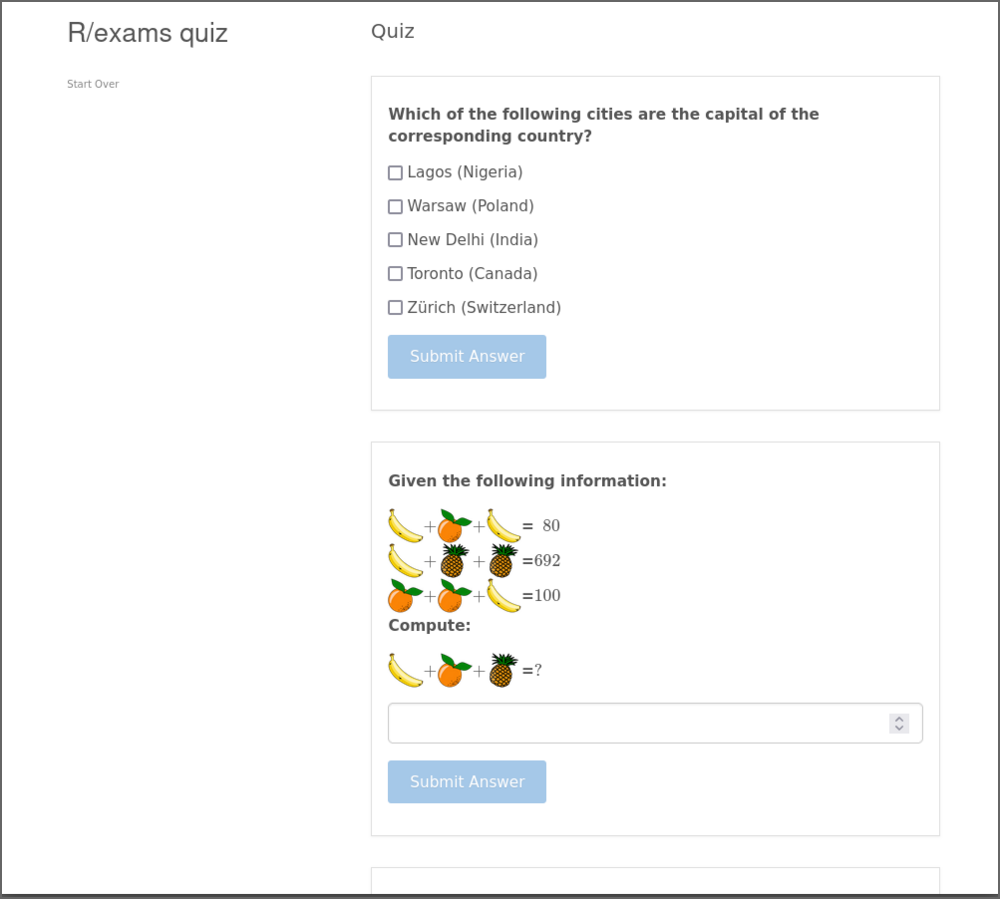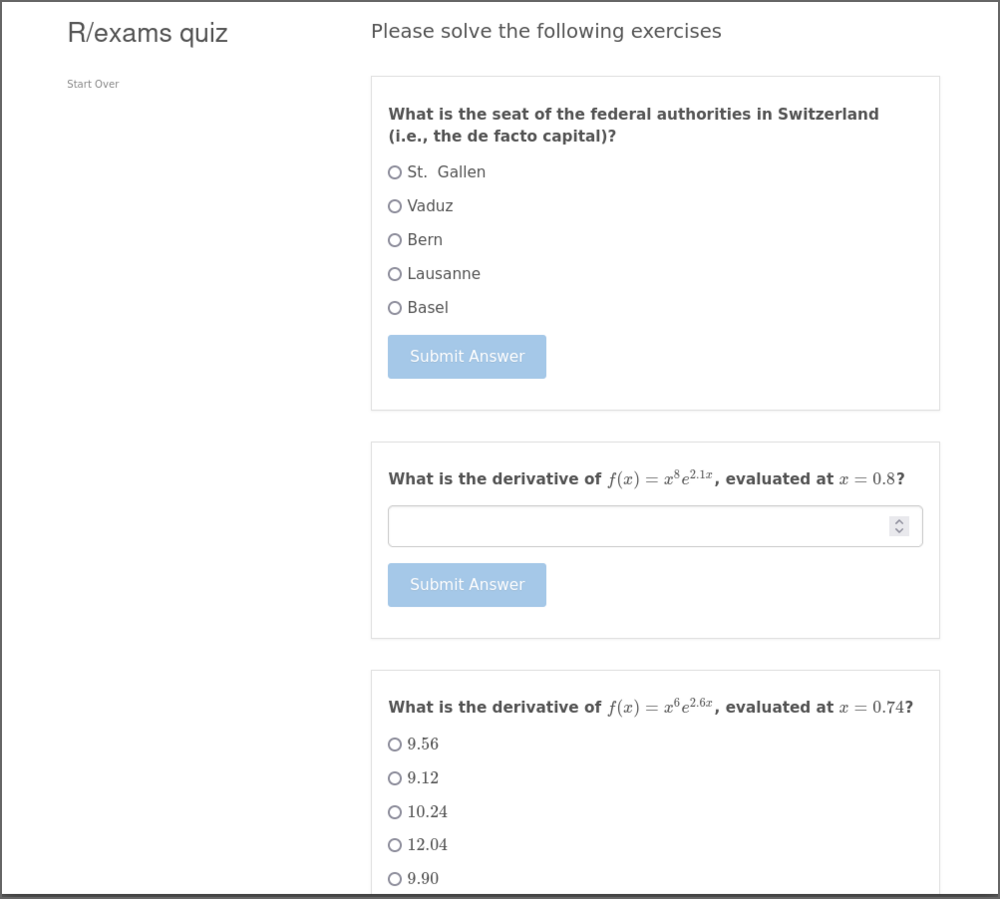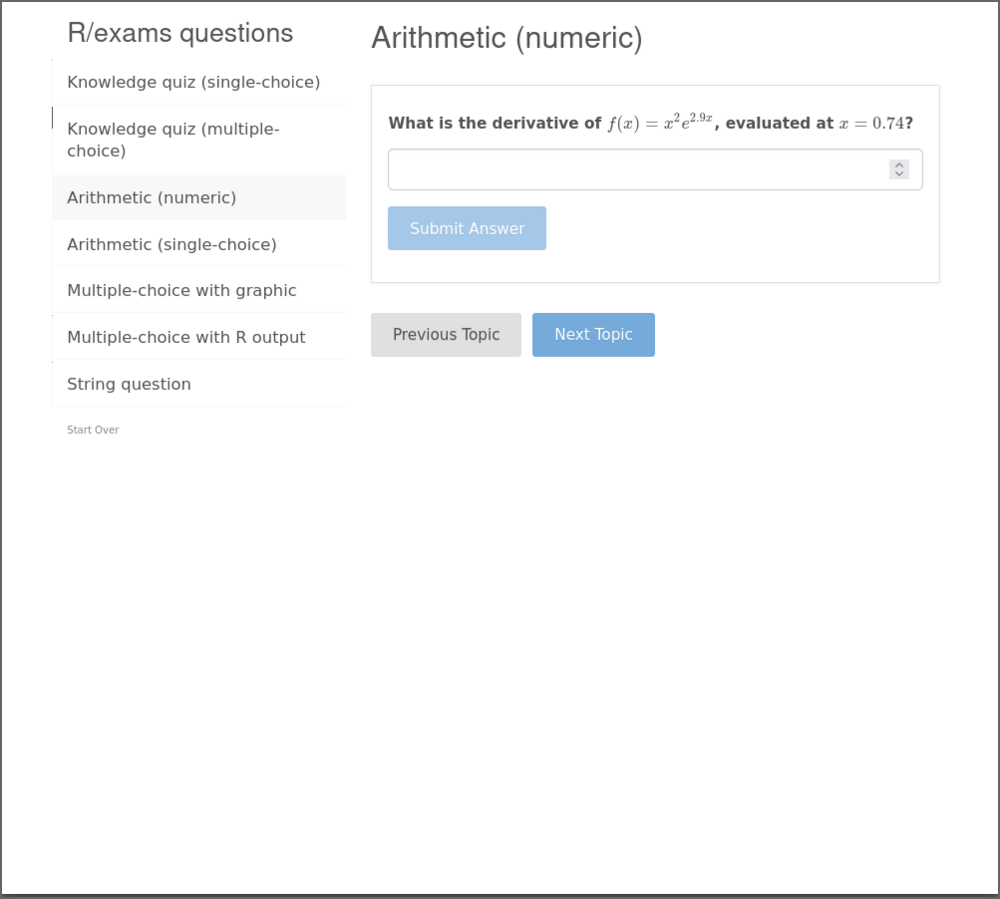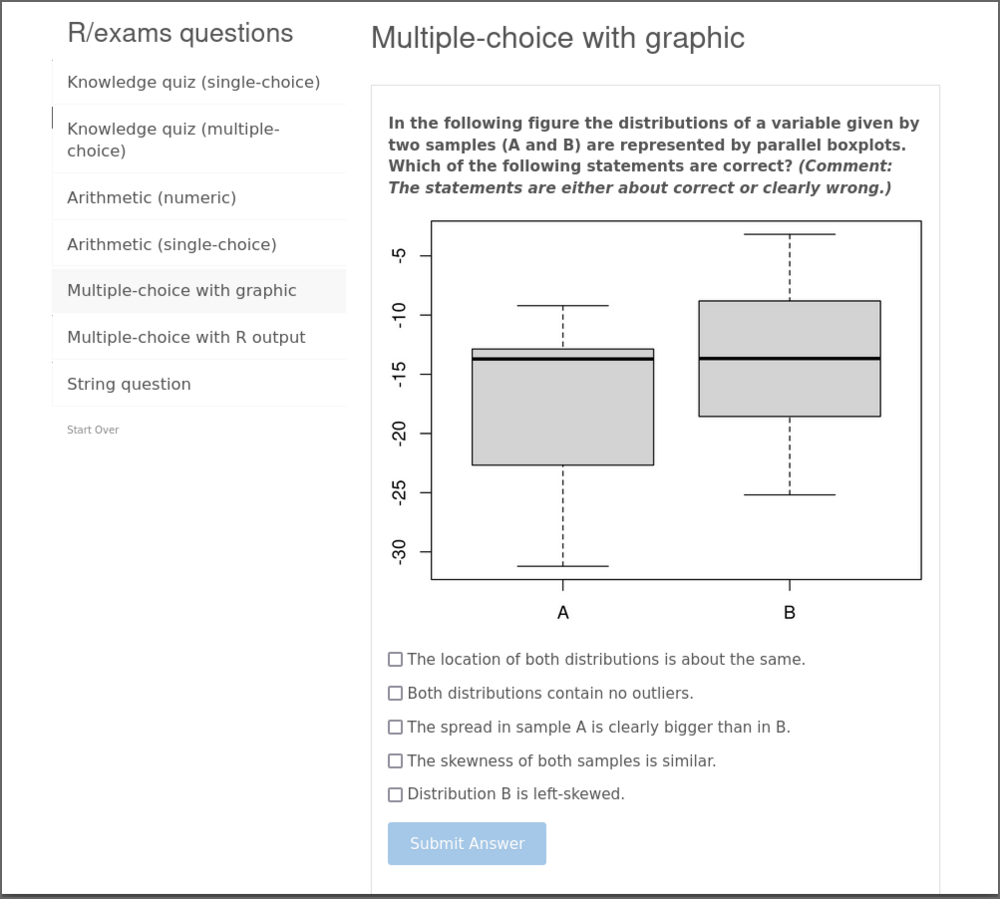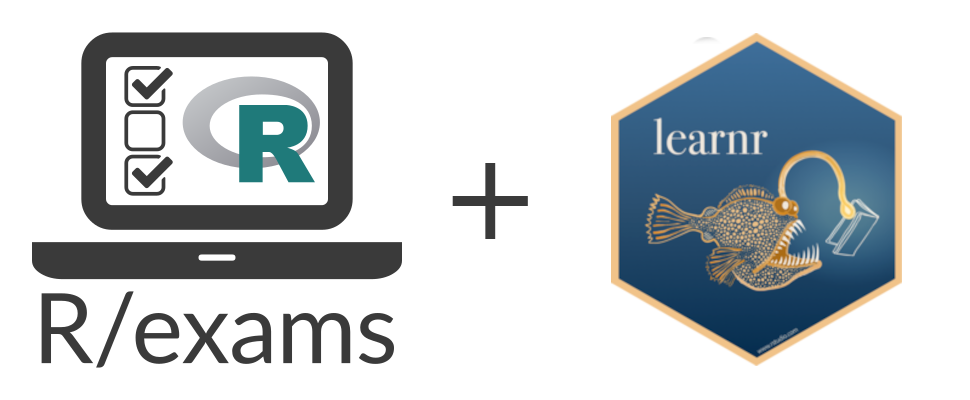
Embedding R/exams Exercises in learnr Tutorials
Overview
The package exams2learnr mainly provides the function of the same name, exams2learnr(). It is an interface for embedding exercises written with R/exams in tutorials or quizzes written with the learnr package.
The goal of learnr is the creation of interactive tutorials in a shiny application written with R/Markdown. The tutorials can contain individual questions (exercises) or quizzes (sets of exercises) along with text, graphics, and other elements you can embed in R/Markdown. Usually, these tutorials can then be used for self-paced learning rather than (summative) assessment.
The exams2learnr() interface leverages learnr’s capabilities for questions/quizzes to dynamically insert (random variations) from R/exams exercise templates, either written in Rmd (R/Markdown) or Rnw (R/LaTeX) format. Currently, there is support for the following question types:
| Description | R/exams | learnr |
|---|---|---|
| Single-choice | schoice | learnr_radio |
| Multiple-choice | mchoice | learnr_checkbox |
| Numeric | num | learnr_numeric |
| Text | string | learnr_text |
Thus, there is no support, yet, for cloze questions that can combine all of the elements above.
First motivation
For quickly trying out how a certain R/exams exercise is rendered in a learnr tutorial, there is the convenience function run_quiz(). This sets up a tutorial embedding R/exams exercises in a temporary directory and directly runs the tutorial in a shiny app. For illustration, the code below creates a quiz containing one random version of each of these exercises that are shipped with the R/exams package: capitals (multiple-choice), fruit (numeric), function (string/text). A screenshot is included below the code.
library("exams2learnr")
run_quiz(c("capitals.Rmd", "fruit.Rmd", "function.Rmd"))
Thus, the run_quiz() function is nice for getting a first feeling for what is possible with the exams2learnr package and for the look & feel of the resulting shiny apps. For full customization, however, a dedicated Rmd tutorial should be set up. This can then leverage the main exams2learnr() function to explicitly include questions/quizzes, potentially along with further elements and/or customizations.
Building blocks
The main function exams2learnr() can take one or more exercise templates, either as a vector or as a list, just as for other exams2xyz() interfaces. By default, this creates a single random replication from (each of) the exercise(s), converts the text to HTML, and wraps it into a suitable learnr object. For a single exercise a tutorial_question is returned and for a vector/list of exercises a tutorial_quiz. These defaults can be modified and further arguments can be passed on to the underlying learnr function calls to question() and quiz(), respectively. This allows for customizing the appearance or controlling whether multiple attempts are allowed, or whether hints/solutions are shown, etc.
As a first example, we apply exams2learnr() to the string/text function exercise, readily provided within the R/exams package. The result is represented as a learnr_text object, inheriting from tutorial_question:
qn <- exams2learnr("function.Rmd")
class(qn)
## [1] "learnr_text" "tutorial_question"
print(qn)
## Question: "What is the name of the R function for extracting the fitted
## log-likelihood from a fitted (generalized) linear model object?"
## type: "learnr_text"
## allow_retry: FALSE
## random_answer_order: FALSE
## answers:
## ✔: "logLik"
## messages:
## correct: "Correct!"
## incorrect: "Incorrect"
## message: "<code>logLik</code> is the R function for extracting the
## fitted log-likelihood from a fitted (generalized) linear model object.
## See <code>?logLik</code> for the corresponding manual page."
## Options:
## trim: TRUE
Subsequently, we set up a quiz with the single-choice swisscapital exercise and the multiple-choice switzerland exercise, represented as learnr_radio and learnr_checkbox objects, respectively, contained in a tutorial_quiz.
qz <- exams2learnr(c("swisscapital.Rmd", "switzerland.Rmd"))
class(qz)
## [1] "tutorial_quiz"
print(qz)
## Quiz: "Quiz"
##
## Question: "What is the seat of the federal authorities in Switzerland
## (i.e., the de facto capital)?"
## type: "learnr_radio"
## allow_retry: FALSE
## random_answer_order: FALSE
## answers:
## X: "Zurich"
## X: "Basel"
## ✔: "Bern"
## X: "Vaduz"
## X: "Geneva"
## messages:
## correct: "Correct!"
## incorrect: "Incorrect"
## message: "There is no de jure capital but the de facto capital and
## seat of the federal authorities is Bern.</p>
##
## <ul>
## <li>False</li>
## <li>False</li>
## <li>True</li>
## <li>False</li>
## <li>False</li>
## </ul>
## "
##
## Question: "Which of the following statements about Switzerland is correct?"
## type: "learnr_checkbox"
## allow_retry: FALSE
## random_answer_order: FALSE
## answers:
## X: "The currency in Switzerland is the Euro."
## ✔: "Italian is an official language in Switzerland."
## ✔: "The Swiss national holiday is August 1."
## X: "Switzerland is part of the European Union (EU)."
## X: "Zurich is the capital of Switzerland."
## messages:
## correct: "Correct!"
## incorrect: "Incorrect"
## message: "<ul>
## <li>False. The currency is the Swiss Franc (CHF).</li>
## <li>True. The official languages are: German, French, Italian, Romansh.</li>
## <li>True. The establishment of the Swiss Confederation is traditionally dated to August 1, 1291.</li>
## <li>False. Switzerland is part of the Schengen Area but not the EU.</li>
## <li>False. There is no de jure capital but the de facto capital of Switzerland is Bern.</li>
## </ul>
## "
If more than n = 1 random replications are produced then a standard list is returned - because learnr currently does not provide a compound object that can capture a question bank with multiple replications. The list has one element per random replication, each of which is a list of tutorial_question objects.
The format of the return value can also be controlled by the output argument if the desired format is not selected automatically.
Tutorial with a quiz
For setting up a learnr tutorial with a quiz based on R/exams exercises the building blocks discussed above can be used. In the YAML header the output should be learnr::tutorial and the runtime should to be shiny_prerendered. Then the quiz (or “exam”) can be set up as a list of exercise templates, as for other exams2xyz() interfaces as well. The entire quiz is then prepared in a single exams2learnr() call. For illustration consider:
---
title: "R/exams quiz"
output: learnr::tutorial
runtime: shiny_prerendered
---
```{r setup, include = FALSE}
## package and list of various exercises
library("exams2learnr")
exm <- list(
c("swisscapital.Rmd", "capitals.Rmd"),
"deriv.Rnw",
"deriv2.Rnw",
"fruit.Rmd",
"boxplots.Rmd",
"ttest.Rmd",
"function.Rmd"
)
```
```{r rexams_quiz, echo = FALSE, message = FALSE}
exams2learnr(exm, caption = "Please solve the following exercises")
```
The demo file above is actually shipped as a supplementary file learnr_quiz.Rmd within the exams2learnr package. Hence, it can be run() as in the following command. The screenshot below shows (one random replication of) the first exercises. The concrete exercises will differ in every new run() of the tutorial.
rmarkdown::run(system.file("learnr", "learnr_quiz.Rmd", package = "exams2learnr"))
Tutorial with individual questions
To finetune the appearance of the R/exams exercises within the learnr tutorial, e.g., for putting different exercises into different sections, it may be necessary to include each question/exercise individually (rather than an entire quiz). For illustration consider the following Rmd document that is provided as supplementary file learnr_questions.Rmd:
---
title: "R/exams questions"
output: learnr::tutorial
runtime: shiny_prerendered
---
```{r setup, include = FALSE}
library("exams2learnr")
```
## Knowledge quiz (single-choice)
```{r schoice1, echo = FALSE, message = FALSE}
exams2learnr("swisscapital.Rmd", allow_retry = TRUE, incorrect = "Incorrect, try again.")
```
## Knowledge quiz (multiple-choice)
```{r mchoice2, echo = FALSE, message = FALSE}
exams2learnr("capitals.Rmd")
```
## Arithmetic (numeric)
```{r num3, echo = FALSE, message = FALSE}
exams2learnr("deriv.Rnw", allow_retry = TRUE)
```
## Arithmetic (single-choice)
```{r schoice4, echo = FALSE, message = FALSE}
exams2learnr("deriv2.Rnw")
```
## Multiple-choice with graphic
```{r mchoice5, echo = FALSE, message = FALSE}
exams2learnr("boxplots.Rmd")
```
## Multiple-choice with R output
```{r mchoice6, echo = FALSE, message = FALSE}
exams2learnr("ttest.Rmd")
```
## String question
```{r mchoice7, echo = FALSE, message = FALSE}
exams2learnr("function.Rmd", allow_retry = TRUE)
```
This tutorial also shows how to use some of learnr’s customization options such as allow_retry or incorrect. To run() this tutorial the command below can be used. As in the previous section, the concrete exercise variations will differ in every new run() of the tutorial.
rmarkdown::run(system.file("learnr", "learnr_questions.Rmd", package = "exams2learnr"))
